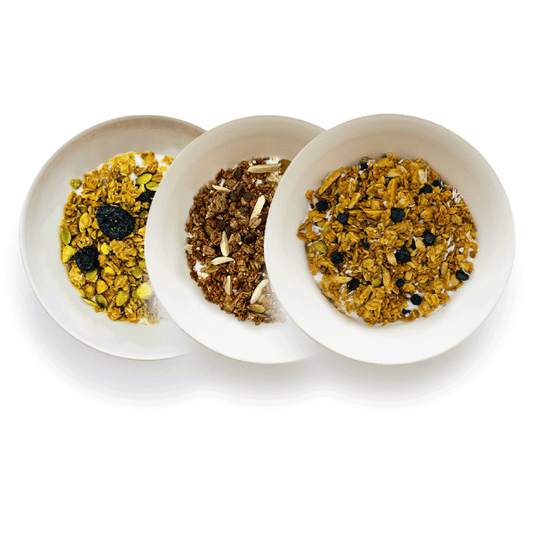Sooo... What’s Up with Soy? Exploding Three Myths about this Powerful Plant-based Protein
By Kristen Sunstrum, RD

The very first time I tried soymilk, I was surprised. It wasn’t the bland, cardboard-tasting flavour that has been drilled into my mind over the years. Instead, it was slightly sweetened with vanilla, creamy and refreshing. The best part? It was a protein rich, plant-based beverage.
Despite its versatility and solid nutritional value, soy milk and soy products have gotten a bad rap over the past few years, fueled by a mix of misinformation around nutrition and health and the horror stories of a friend-of-a-friend who didn’t enjoy tofu once.
So, what’s the deal with soy? In this article, we will debunk the top three myths around these plant-based powerhouse foods, and why you should consider including them into your diet.
Myth 1: Soy Foods Increase Estrogen Levels
Has anyone ever told you that drinking too much soy milk can cause “man boobs” or mess with your hormone levels because soy contains estrogen?
To date, not a single scientific study has been able to find a cause and effect relationship between soy intake and breast growth in men. This is because soy products contain phytoestrogen, not human estrogen. Phytoestrogen is a weak, plant version of estrogen that cannot cause the same effects as human estrogen.
In fact, the human body considers phytoestrogens to be a beneficial phytochemical known as isoflavones. Isoflavones are beneficial to human health and can help reduce the risk of heart disease and might even reduce the risk of prostate cancer in men [1,2]. Look no further than the denizens of Okinawa, Japan -- reportedly among the oldest, healthiest populations in the world. Many factors contribute to this oasis of wellbeing but researchers point to a relatively high level of soy consumption as a factor [3].

Myth 2: Soy Foods are Tasteless
Soy products originated in Southeast Asia in 1100 BC [4]. These cultures have been transforming soybeans into delicious delicacies, like fermented natto, ripe edamame, pressed tofu and smokey tempeh for thousands of years.
In the western world, soy products are relatively new. In the 1970s, soy milk was only known in fringe-groups as a hippie drink. Now, 35% of Americans consume soy products at least once per week [5].
So it’s not unreasonable to blame the tasteless narrative that surrounds soy on the trial and error we experienced bringing soy products into the western world. Thanks to improvements in our soy preparation skills complemented by advancements in the food industry, there are an abundance of delicious soy products on the market today.
The key with preparing tasty soy products at home comes down to versatility. Think of tofu as a blank canvas for a myriad of your favourite sauces, spices and flavours. Firm tofu can replace traditional meats and soak up the flavours in stir-fries, curries and soups. Soy milk can be blended into your favourite smoothies or added to oatmeal, creating a creamy texture and adding a punch of protein.
Myth 3: Soy Protein is Suboptimal for Muscle Building
To build muscle, we need two things: a metabolic need and an adequate amount of complete protein. A metabolic need can be created with muscle-building exercises, and adequate amounts of complete protein can be found in animal or soy products.
Soy products are one of the best complete plant-based proteins for muscle building. A complete protein means that it includes all nine essential amino acids required for muscle repair and growth.
In fact, a recent study found no difference between soy and animal products when it comes to muscle building [6]. Soy milk is also considered to be nutritionally equivalent to cow’s milk, delivering around 6 to 8 grams of protein per cup.
The most important amino acid for muscle building is leucine, as it jump-starts the muscle protein synthesis process. The International Society of Sports Nutrition recommends that up to 3 grams of leucine are consumed after exercise for muscle building [7], which can be met by mixing and matching soy products. For example:
- 1 cup of tofu has 2 grams of leucine
- 1 cup of tempeh has 2.5 grams of leucine
- 1 scoop (45g) of soy protein powder has 2 grams of leucine
- 1 cup of edamame has 1.7 grams of leucine
What's your deal with soy?
For me, I discovered a love for soy by seeking a dairy replacement and trying vanilla soy milk. For you, it might be to increase your isoflavone consumption, to try a new plant-based protein or to even recover after your workout. Whatever your deal is, give soy a shot, it’s a powerful plant-based food that won’t disappoint. And as with anything, the less processed the better. So look for lightly processed whole food soy products like tempeh or tofu over highly processed powders, bars and fortified soy cereals. Finally, worried about genetic modification in soy? We got you covered there, too. Our tempeh and tofu are both organic and non-GMO.
Check out the following FireRoad meals with soy:
Fermented Tempeh:
Korean Bulgogi + Southern BBQ (fermented tempeh).
High Protein Sprouted Tofu (for bioavailability):











